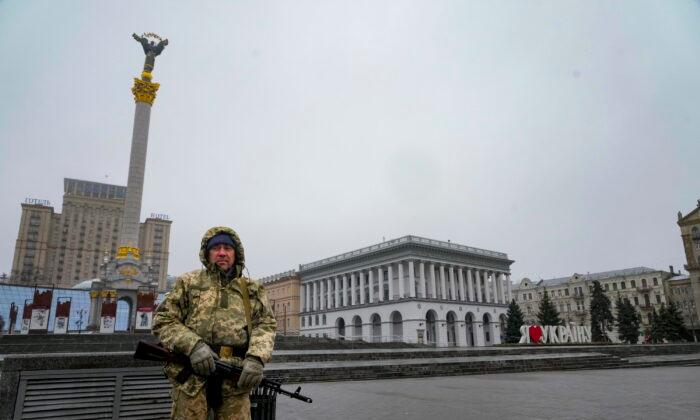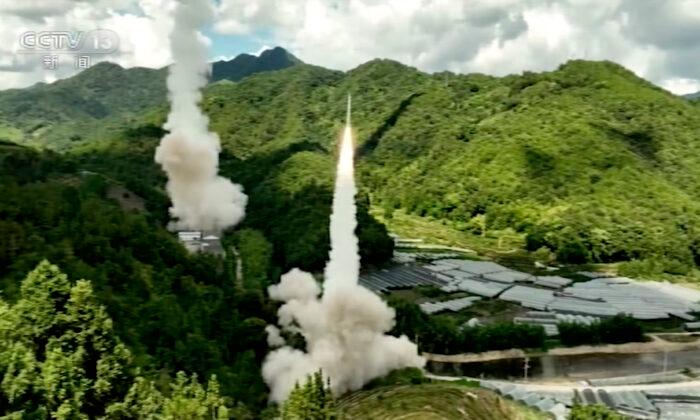Very soon, that failure to deter could extend to the Taiwan Strait.
Following decades of military buildup, Russia and China have simply lost their fear of the United States—they are not “deterred.” This now justifies an immediate U.S. move to “re-MIRV” or replace multiple independently targetable reentry vehicle (MIRV) nuclear warheads removed from its land and sea-based nuclear missiles.
It is crucial to review how Russia and China have justified such a U.S. nuclear rearmament.
Against Ukraine, Putin massed a force of 160,000 or more troops and on Feb. 24 commenced a massive multi-axis invasion for the purpose of turning a neighboring democracy into a Soviet-era-like client state. A similar fate could await the Baltic States and even Poland.
Instead of adhering to the 2010 New START nuclear reduction treaty negotiated with President Barack Obama that committed both sides to a deployed nuclear warhead count of 1,550, Putin has spent the last decade building new nuclear weapons not covered by New START, like the Avangard nuclear hypersonic glide vehicle and the Poseidon large nuclear torpedo.

This is in addition to Russia’s estimated 2,000 (or many more) theater nuclear weapons mainly threatening NATO, which may include new sub-kiloton “low yield” nuclear weapons designed to destroy concentrations of NATO ground forces or to obliterate villages.
Russia and China also have spent the last decade deftly assembling a military alliance based on clear opposition to the United States and democracy, and mutual support for their respective imperialist ambitions, including Moscow’s restoration of Soviet-era dominion in Europe, and Beijing’s invasion and destruction of the democracy of Taiwan.
Also, having for decades touted its preference for a small nuclear arsenal, by early 2021, it became clear that China had a new goal of achieving nuclear superiority. Building 350 or more missile silos, each of which could be armed with 10 warhead intercontinental ballistic missiles (ICBMs), along with more submarine launched ballistic missiles (SLBMs) and intercontinental bombers, points to a possible 4,000 warheads by the late 2020s.
This may become the greatest ever nuclear threat to the United States, as Russia and China’s growing cooperation over the last decade in “missile defense” could mirror a much more threatening cooperation in “missile offense” in which they combine their nuclear warheads for coercive or massive nuclear strike operations against America.
In one of his first major foreign policy decisions, in a Jan. 26 phone call with Putin, President Joe Biden agreed to extend the New START Treaty by five years to 2026, locking the United States into a deployed warhead count of 1,550.
However, should China and Russia proceed with their nuclear modernization and buildups, by 2026 their combined nuclear forces could exceed 3,000 warheads, which, along with their many thousands of theater nuclear weapons, would enable overwhelming nuclear superiority to blackmail or strike America and its allies.
To build a greater sense of fear/deterrence in Moscow and Beijing, it is necessary to reverse the U.S. nuclear reductions of the 2010 New START Treaty, which saw the United States reduce its deployed warheads from 2,200 to less than 1,550.
By some counts, if the United States puts three warheads on its 400 Minuteman ICBMs (now reduced to one warhead), and rearmed its 280 Trident II SLBMs on 14 Ohio class nuclear ballistic missile submarines, it could deploy up to 3,200 warheads.
To be clear, when Putin issued his Feb. 27 order of placing his nuclear forces on high alert, he was asserting his ability to use nuclear weapons to destroy Ukraine’s democracy in the face of valiant opposition by Ukrainian military and mobilized civilian forces.
Putin made a vaguer nuclear threat in a Feb. 24 speech, warning, “Those who may be tempted to interfere in these developments from the outside … they must know that Russia will respond immediately, and the consequences will be such as you have never seen in your entire history.”

Putin was also seeking to deter NATO from providing Ukraine with new fighter jets, and to deter the United States, Britain, Germany, Sweden, Finland, Romania, the Netherlands, and others from providing new lethal assistance.
But what if U.S. and NATO efforts to supply a long-term resistance in Ukraine requires combat air support to ensure weapons and supplies cross borders into Ukraine, or even air delivery closer to the fighting in Ukraine?
While the United States has dispatched additional combat aircraft and will soon send 7,000 more troops to Europe, Biden, in his Feb. 24 press briefing reacting to Russia’s invasion, stated, “Our forces are not and will not be engaged in the conflict with Russia in Ukraine.”
Placing such limits on the scope of American military options may seem prudent to some, but to others it can be a signal that Putin is successfully limiting the ability of the United States to support Ukraine, even as Russian military forces indiscriminately murder civilians while trying to decapitate the government in Kyiv.
China’s Xi Jinping, who may be preparing for an invasion of Taiwan by mid-decade, or sooner, will take note: superior regional and strategic nuclear weapons can help deter the Americans from defending their friends and allies.
To prevent Russia and China from deterring U.S. support, or limiting U.S. military options for defending its interest and its allies, it is necessary to build up the U.S. deployed nuclear force to about 3,000 warheads by replacing those reduced after the year 2010.
It also should be considered that in this decade the United States may require the deployment of 5,000 warheads on ICBMs and SLBMs, and up to 1,000 theater nuclear weapons each for Europe and Asia. Britain and France should also be urged to increase their total nuclear warheads to at least 1,000.
There is much else that is needed to deter Russia and China. But the key to getting their attention, and convincing them to decide against war in Europe and Asia, is to build up U.S. nuclear forces to a far greater level.





